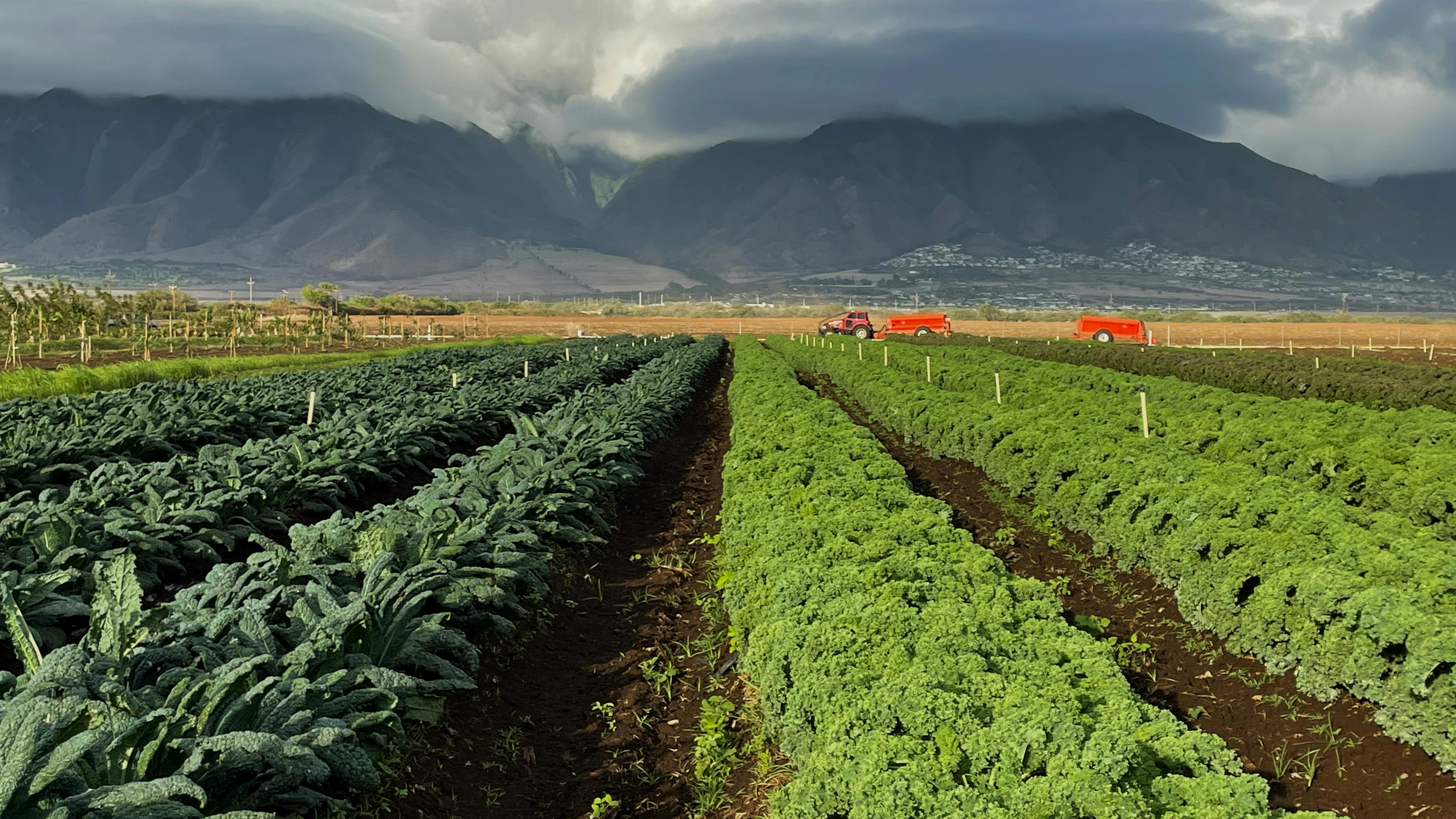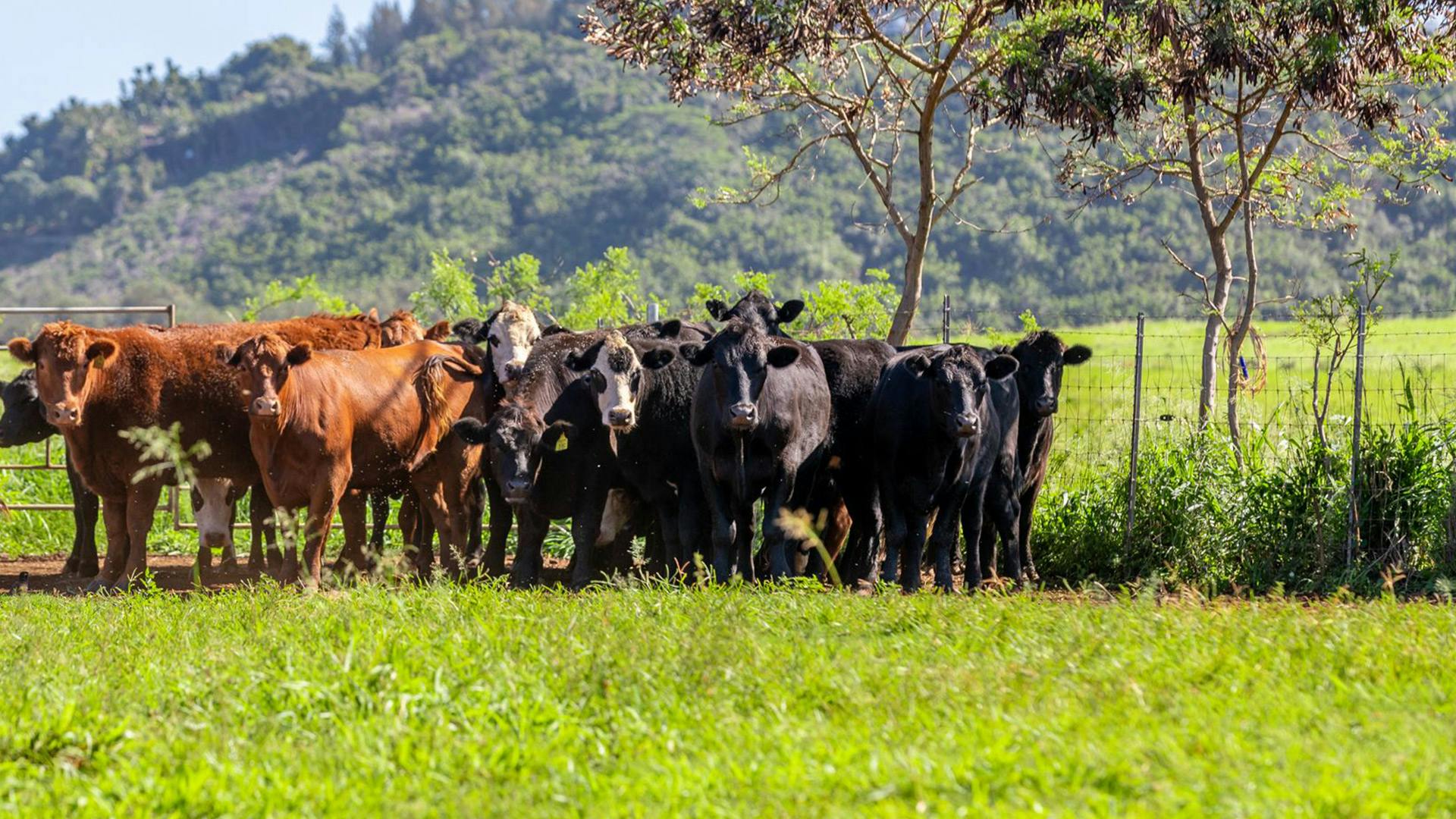Check out our farming plans, from crops, to livestock, to community farming. There will be a variety of crops, including citrus, macadamia nuts, coffee, and onions.

Facts & Figures
Plans for Farming Effort
View our map for crop plans and get answers to frequently asked questions below.
Get the Facts on Some Frequently Asked Questions
How many acres are currently being farmed? 
As of September 1, 2025, Mahi Pono has planted more than 2 million trees on over 13,000 acres of land. In addition to our tree plantings, we have also prepared over 9,000 acres of grass pasture land to support our Maui Cattle Company grass-fed beef operations. We continue to plant more trees as we work toward the full development of our farm.
What type of food crops are currently in the ground? 
Orchard and row crops currently planted include lime, lemon, orange, tangerine, coffee, avocado, macadamia nut, 'ulu, onion, watermelon, bananas, coconut, and lilikoi.
Where can I purchase Mahi Pono produce? 
Products are sold under the Maui Harvest brand, and are available at select retailers & food hubs across the state – including Costco, Safeway, Foodland, Whole Foods, Walmart, Tamura’s, Target, KTA Supermarket, Local Harvest, and Farmlink. As production increases, we will establish additional partnerships with distributors, wholesalers, and chefs that will make our Maui-grown produce available at more stores and restaurants throughout Hawaii.
What steps is Mahi Pono taking towards water conservation?
Mahi Pono is committed to the efficient use of water while working towards increasing local food production for Hawaii. We have selected crops that will result in a significant decrease in water use on the farm compared to sugar cane (previous crop), and have integrated modern technology to better manage and improve the efficiency of our irrigation systems. We are also in the process of installing a weed mat/barrier throughout our orchard plantings. This weed mat will reduce water needs by keeping moisture in the soil while also reducing the need for chemical applications. We estimate that our diversified farm will use 50% less water compared to the previous sugarcane monocrop operation.
We continue to remain fully-transparent in our water conservation efforts and have provided regular reports to the State of Hawaii Department of Land and Natural Resources (DLNR) as required by our water permits.
Does Mahi Pono own and manage East Maui Irrigation (EMI)? 
Starting in January 2019 and continuing until June 2025, Mahi Pono held a 50% ownership stake in EMI and served as EMI’s managing partner. During this time, EMI – at the direction of Mahi Pono – strived to efficiently operate the 70-mile gravity-fed irrigation system to support Mahi Pono’s diversified farming operations in Central Maui. Mahi Pono invested heavily in EMI’s operations and infrastructure, and EMI’s budget regularly exceeded $2.5M on an annual basis.
In June 2025, Mahi Pono became the 100% owner and operator of EMI. Under Mahi Pono’s sole ownership, EMI will continue its mission to efficiently support farming, and to provide water to the County Department of Water Supply for its over 35,000 residents in Upcountry Maui.
Does EMI and Mahi Pono control surface water on Maui?
No. All surface water throughout Hawaii is controlled by the State government through the Board of Land & Natural Resources (the “BLNR”) and the Commission on Water Resource Management (“CWRM”). These entities allow EMI to divert a limited amount of surface water for uses that are beneficial to the public, which include irrigating Mahi Pono’s diversified farm in Central Maui and providing water to residents & farmers in Upcountry, Maui. EMI’s diversions always operate within the State’s surface water limits to ensure full compliance with stream flow standards set by CWRM.
In addition to the limitations placed on EMI’s diversions, the State government also imposes strict conditions on EMI’s water rights. EMI must comply with all of these State-mandated conditions in order to continue to divert water. These conditions include the filing of comprehensive quarterly reports with the State, modifying diversion structures in accordance with State guidelines, and reporting on unexpected uses of the diverted water, such as providing Maui Fire Department with water to fight brushfires. EMI has remained compliant with all of these conditions under Mahi Pono’s management.
Does EMI profit from water deliveries to the County of Maui and Upcountry residents & farmers?
No. EMI delivers up to 6 million gallons of water per day to the County’s Kamaole Weir treatment plant and up to 1.5 million gallons of water per day to the County’s Kula Ag Park. These deliveries make EMI the primary source of water for residents and farmers in Upcountry, Maui.
EMI has prioritized the uninterrupted delivery of water to the County since 1973, the year that the County and EMI originally executed a water delivery agreement for the Upcountry area. The terms of this original agreement included a rate of $0.06 per 1,000 gallons, and this rate remains the same today, almost 50 years later.
The rate of $0.06 per 1,000 gallons – again, held constant since 1973 – makes EMI one of the lowest-cost sources of water available to the County of Maui. EMI’s cost to deliver this water to the County far exceeds this rate, and thus, the water delivered to the County via the EMI system is not profitable to EMI or Mahi Pono.
What is Mahi Pono’s approach to managing the economic impacts of its agricultural operations?
We believe that Mahi Pono’s farming activities will continue to accelerate Maui’s economic diversification. As of September 2024, Mahi Pono has over 400 employees working on farm. Our goal is to create more than 800 jobs in Maui County by the time our crops reach their full harvest potential.
We have also built strong partnerships with local vendors and consultants. We’ve relied on our Maui-based partners for irrigation materials, nursery services, farming equipment, engineering guidance, sales & marketing, and graphic design work. We have – and always will be – strongly committed to supporting and working with the Maui business community.
How is Mahi Pono collaborating with business leaders statewide to promote the advancement of Hawaii’s sustainability goals?
Mahi Pono is a proud member of the Hawaii Green Growth Sustainability Business Forum (“SBF”). The SBF exists to drive private sector action to achieve Hawaii’s statewide sustainability goals. The SBF’s ongoing discussion on initiatives is wide-ranging, and covers areas such as the individual sustainability goals of each member company, potential opportunities to promote sustainability-focused policies/legislation at the State and County levels, and the potential for partnerships between members for the advancement of sustainable business practices.
The SBF membership includes companies such as Hawaiian Electric Company, Bank of Hawaii, Kamehameha Schools, First Hawaiian Bank, Kualoa Ranch, Hawaii Pacific University, and Hawaiian Airlines. Members are represented by leaders at the c-suite executive level.
Mahi Pono is one of the few SBF members from the food and agriculture industry, so one of our priorities within the SBF is to drive the discussion on the State’s food security situation. Beginning in 2023 the SBF’s newly established Local Food Working Group – of which Mahi Pono serves a co-chair – will identify and lead concrete action initiatives to support and enhance local food supply chains by increasing the market for local food products.
The SBF has also committed to support the State’s Aloha+ Challenge to achieve Hawaii’s sustainability goals, which include doubling the amount of local food production by 2030.
